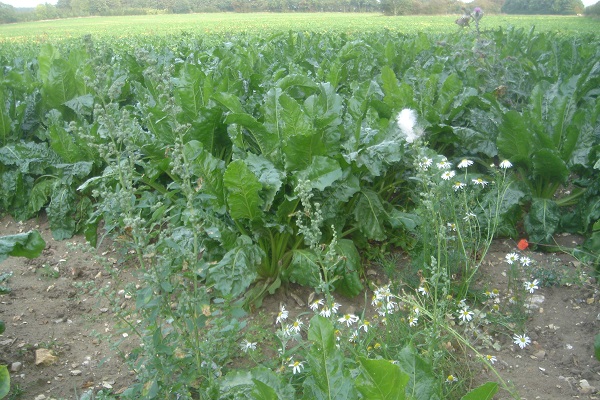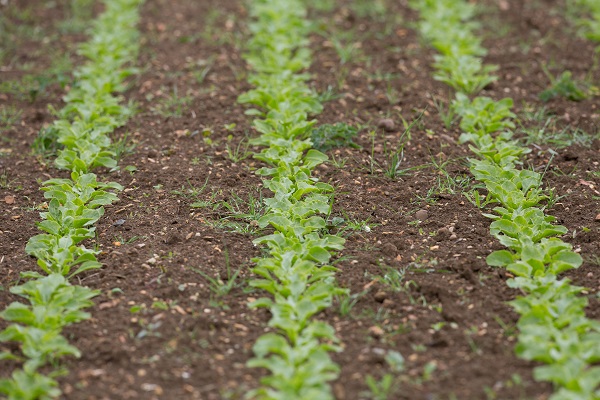Sugar beet has been adopted as a blackgrass solution by a Suffolk grower after a long absence from growing the crop. CPM asks guidance for newcomers from an established grower and agronomist.
With sugar beet you’re not a grower, you’re a driller.
By Lucy de la Pasture and Rob Jones
Some 42 years after the UK joined the European Community, growers can once again produce sugar beet without first needing to obtain an entitlement. For some, this is an opportunity not be to be missed while for those wishing to continue growing the crop, it’s motivation to maintain improving performance.
One new grower is Richard Styles of Tudor Farms, Debenham, Suffolk. After a 27-year absence he will grow sugar beet again on his heavy land farm this spring. Improvements to beet loader design and advances in tyre technology mean soil damage is no longer the threat it once was, but what ultimately persuaded him to return to the crop was blackgrass.

Tall weeds have a dramatic effect on potential crop yields in sugar beet.
“We considered growing sugar beet four years ago when contract could be purchased for £2/t, but at the time wheat was still more profitable. But back then we didn’t have a rampant blackgrass problem. Today, we have it in patches, but if we’re not careful it will soon be across the whole farm,” he says.
He regards blackgrass as one of the principal threats to farm profitability and is changing his rotation dramatically in the hope of reversing its progression.

“Our winter wheat area has fallen from 78% of the farm to just 22%. This is partly due to poor market prices, but also because in 2016, we spent £130/ha on autumn herbicides which is simply not sustainable.”
Despite this level of spend, his costs of production for wheat would be in the top quartile of the industry at around £110/t. This he attributes to good average yields and a careful variety selection.
“KWS Siskin averaged 10.75t/ha and while it made specification, the premium was poor, but this was offset by being cheaper to grow than other milling varieties,” he says.
He has come to see rotation as the best means of gaining control of blackgrass and sugar beet will be followed by spring barley to give two consecutive years of spring crops.
“A proactive rotation is our best chance of tackling blackgrass. We’ll use the opportunity afforded by sugar beet to make it the priority weed. A lot will depend on soil conditions, but if favourable we will make good use of residuals and Centurion Max (clethodim) before focussing on broadleaf weeds.”
Fortunately, although there have been no major changes in active ingredients available for use in sugar beet, formulations have improved greatly in recent years. So Richard Styles is hopeful broadleaf weed control won’t be compromised by the need to keep on top of blackgrass.
“In Betanal maxxPro (desmedipham+ ethofumesate+ lenacil+ phenmedipham) we have a herbicide with a good crop safety profile that supports a flexible approach. I’m confident that with some favourable conditions we should achieve our goals,” says Mr Styles.
For Christopher Rutterford of Little Thornes Farm, Swaffham, sugar beet represents the most profitable break crop option available.
“We’re aiming for upwards of 80t/ha, but even at 75t/ha it competes strongly with cereals. The interest in the crop from new growers isn’t surprising,” he says.
He believes that sugar beet growers have benefitted considerably from other people’s efforts.
“Breeders have made great strides in variety potential, while machinery manufacturers have done much to address concerns over compaction. This has done much to support the crop on heavy land sites, while fungicides have enabled us to maintain canopy health through the autumn.”
So, what would be the best advise he’d share with any new or returning grower?
“Establishment is the basis of reliable performance. I often say that with sugar beet you’re not a grower, you’re a driller because if you get that wrong you’re finished. The weather has an influence of course, but if you start well you’re well placed to take on Mother Nature.”
Herbicide selection is still a consideration, but not to the extent it once was, he reckons.
“Chemicals have improved markedly in the past decade. The active substances are much the same as 30 years ago, but formulation has changed dramatically with the development of oil dispersion (OD) mixes. They’re now far safer and more effective.”
Sugar beet agronomist Dr Pat Turnbull adds to the advice to new growers. “Controlling weeds early in sugar beet is vital if growers are to achieve a low unit cost of production and it’s the key to achieving higher yields.
“Getting control strategies right is important, or you’ll always be playing catch up and in the long run this will be more expensive. Hit broadleaf weeds hard and early, using a mix of contact and residual-acting herbicides,” she advises.
“Compromising weed control can soon tip the balance to a position that you can’t come back from and it’s the taller weeds that are the real problem. An infestation of just one tall weed species/m2, such as fat hen or redshank, in a crop can potentially reduce yields by 10%. Bad weed control can knock yields by 30%.”
Pat Turnbull says that weed control in sugar beet has always been about finding the right strategy. The move towards having a single, high-tech sprayer on the farm covering a large number of hectares and a wide range of crops, has meant that the multi-pass herbicide, low dose, post-emergence strategies, applied at close intervals have become more of a challenge.
“Growers simply don’t have the time to get so many applications on the crop at such a busy time of year, so adopting a two-spray programmme known as ‘Broadacre’ that uses robust multi-active herbicide mixes can have a positive impact on control.”
According to Pat Turnbull, critical to the success of the ‘Broadacre’ approach is the application rate of key actives triflusulfuron-methyl and ethofumesate – the latter included as the ‘activator’ – depending on the weed threat, but if weeds are bigger, or the spray has been delayed, then raising the rates of these two are essential and should be adjusted accordingly.
“Weed control in sugar beet must be programmed, with applications timed as flushes of weeds emerge. And it’s important that sprays are based on the crop’s growth stage, because as the size of the beet seedlings increases, they can cope with stronger herbicide mixes,” she says.
She says for some growers a move that relies on a two-spray Broadacre programme is perceived as risky, especially when large numbers of weeds emerge early alongside the sugar beet.
“We often recommend a broad-spectrum system on some farms where the two strong hits with triflusulfuron-methyl and ethofumesate are used at the second and the third post-emergence timings. With this approach, it’s normally a grower’s preference to apply a pre-emergence herbicide and the product of choice is chloridazon as a relatively cost-effective start. This pre-em predisposes the weeds to post-emergence sprays and gives a little more timing flexibility,” she explains.
“The first early post-emergence herbicide application must be at the cotyledon to one true-leaf stage, with a robust mix based on phenmedipham, ethofumesate, metamitron and desmedipham, giving safety and early broad-spectrum control,” she advises.
“Some growers might include Debut (triflusulfuron-methyl) in the first application, if there’s an early emergence of actively growing weeds, but typically we find it’s most effective when applied as the second spray 10-14 days after the first, specifically for brassicas, cleavers and some polygonums such as redshank and pale persicaria. This is then usually followed with a final Debut-based spray.
“Debut also adds to blackgrass control. Both anecdotally and in BBRO trials, carried out at Brant Broughton in Lincolnshire in 2013, they showed that two applications of triflusulfuron-methyl added to blackgrass control compared to a standard mix,” adds Pat Turnbull.




